Sustainability Data
Performance Data
Suntory Beverage & Food Group has brought together its performance for the main indicators (management, environment, and society) on our sustainability site and other media.
Actual results marked with ★ have received independent assurance by KPMG AZSA Sustainability Co., Ltd. In accordance with International Standard on Assurance Engagement (ISAE) 3000 and ISAE 3410.
Key Financial Data
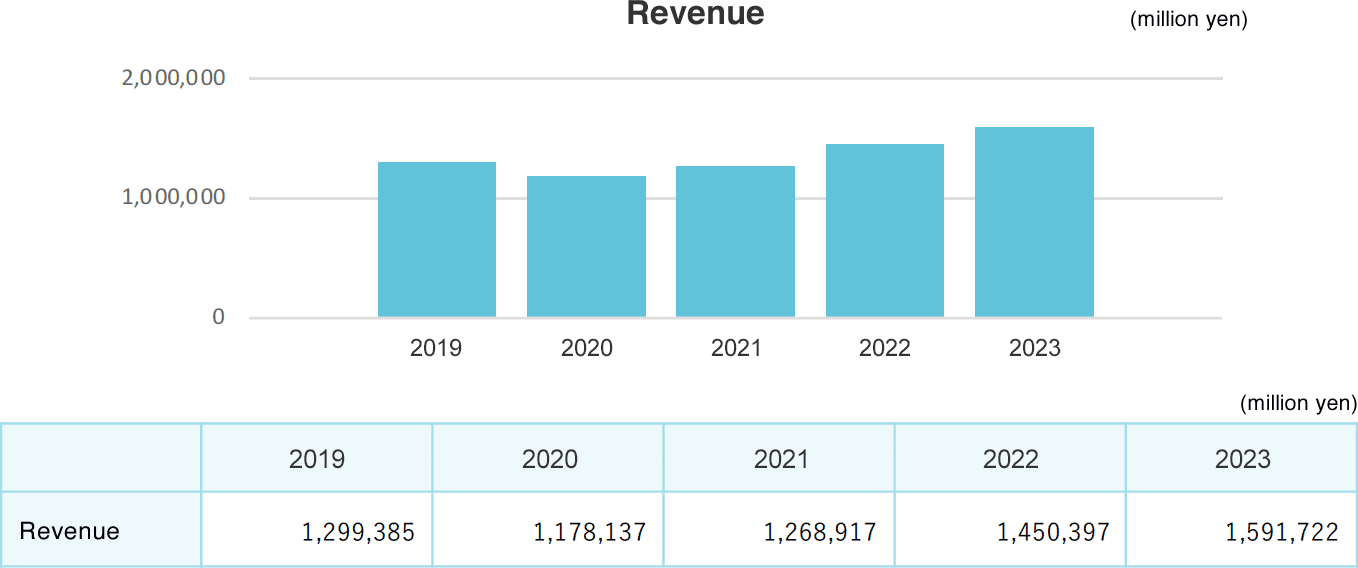
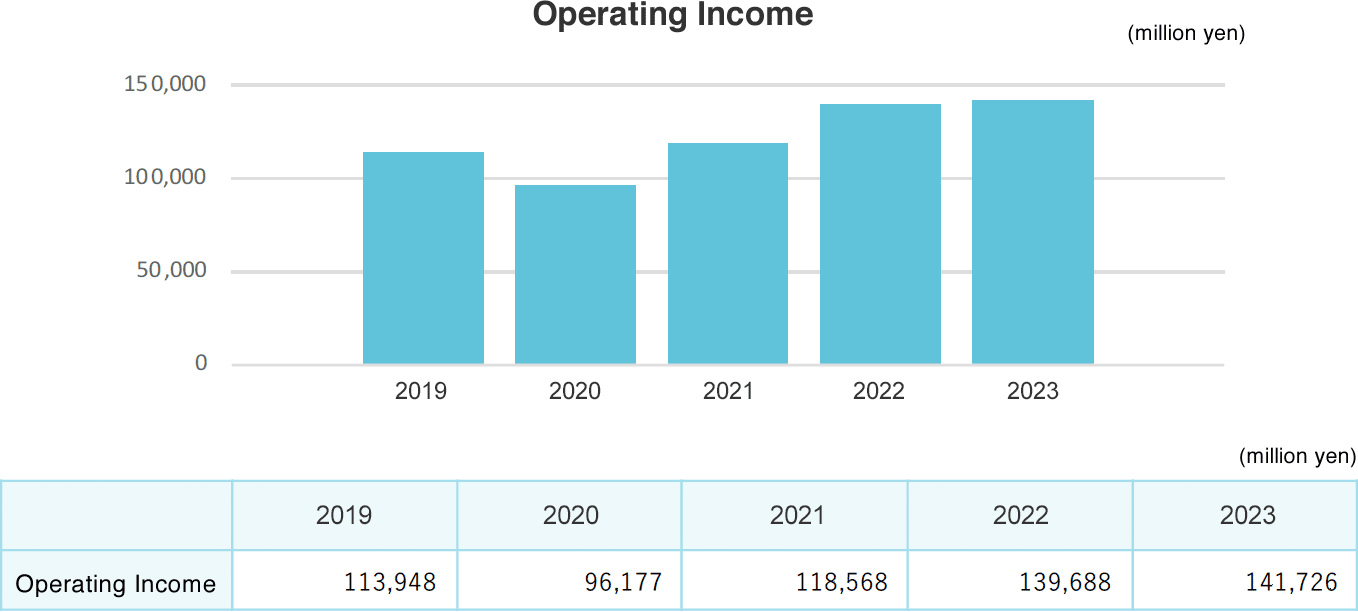
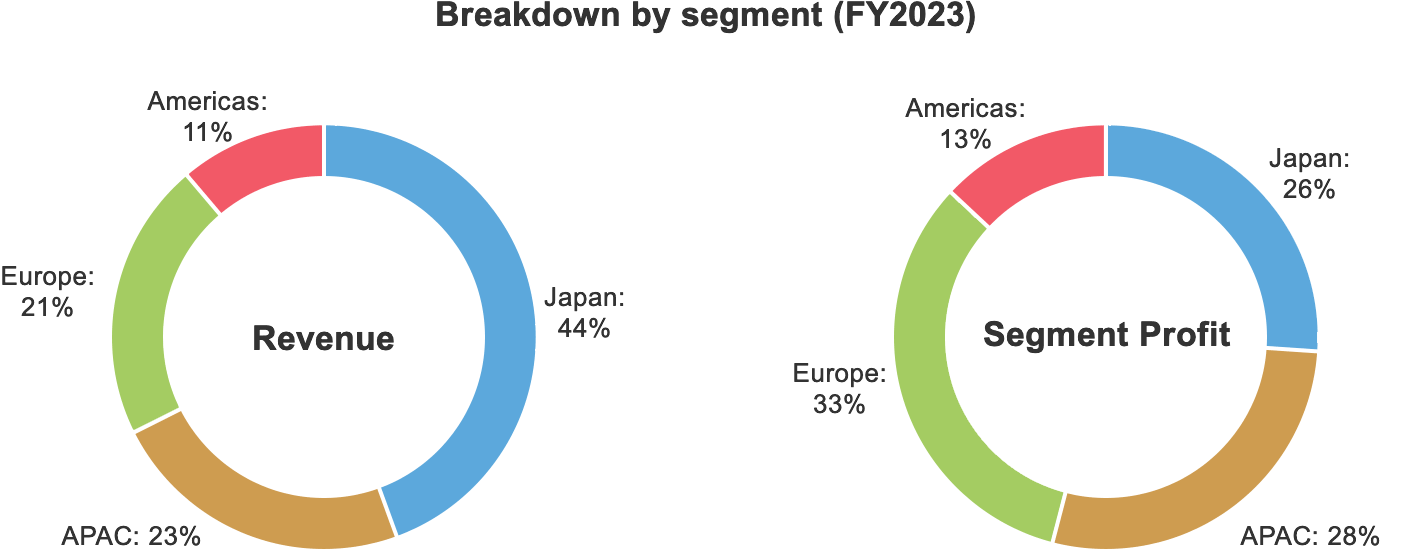

Environmental Data
Water
Targets Toward & Progress at Suntory Beverage & Food
Targets
Toward
2030
- Reduction of water used in direct operation
Reduce the water intensity of production at our owned plants*1 by 20%*2 globally. In addition, explore reduction of absolute amount of water withdrawn in highly water stressed areas. - Water replenishment
Replenish more than 100% of water used in at least 50% of our owned plants*1 globally, including those in highly water stressed areas, through local water source conservation efforts. - Sustainable water use in raw ingredients
Collaborate with suppliers to improve water-use efficiency in the production of water-intensive key ingredients*3 in highly water stressed areas. - Water education and access to safe water
Expand water education programs and initiatives to provide safe water access for more than 5 million people. *4
2023
Progress
- Reduced per consumption of water by 21% compared to 2015
- Implemented water resource cultivation activities in 32% plants worldwide.
Plants located in highly water stressed areas, activities are implemented in 33% of these areas. - Gain and understand information on water management of tier 1 suppliers through Sedex.
- Water enlightenment program: 710,000 people
Provision of safe water: 360,000 people,
Total 1,070,000 people*5
-
*1Owned plants that manufacture finished products and excludes plants for packaging and ingredients
-
*2Reduction of water intensity of production based on 2015 baseline year
-
*3Coffee etc.
-
*45 million people is Suntory group's target
-
*5Total 1,070,000 people is Suntory group's progress
Water Stewardship at Suntory Beverage & Food
| 2015 (base year) |
2021 | 2022 | 2023 | |
|---|---|---|---|---|
| Total water withdrawal (thousand m3) | - | 21,776 | 22,916 | 22,450★ |
| Water intensity (m3/kl) | 2.9 | 2.4 | 2.3 | 2.3 |
| Total water discharge (thousand m3) | - | 12,443 | 11,948 | 11,682★ |
| Total water consumption (thousand m3) | - | - | 10,968 | 10,768 |
-
*2023: Data covers 10 production plants in Japan and 38 production plants overseas.
-
*Results have received independent assurance from KPMG AZSA Sustainability Co., Ltd. The assured numerical values are indicated with ★.
Water Withdrawal from Areas at Suntory Beverage & Food
| Area | Water withdrawal (thousand m3) | |||||
|---|---|---|---|---|---|---|
| 2015 (base year) |
2019 | 2020 | 2021 | 2022 | 2023 | |
| Japan | 10,708 | 10,628 | 10,332 | 10,240 | 10,786 | 10,786 |
| Americas | 1,286 | 1,273 | 1,442 | 1,505 | 1,541 | 1,413 |
| Europe | 3,861 | 3,518 | 3,119 | 3,315 | 3,434 | 3,363 |
| Asia | 4,490 | 7,152 | 6,362 | 6,208 | 6,757 | 6,466 |
| Oceania | 562 | 438 | 444 | 424 | 397 | 422 |
| Africa | 216 | 129 | 89 | 84 | 0 | 0 |
| Total | 21,122 | 23,138 | 21,789 | 21,776 | 22,916 | 22,450★ |
-
*2023: Data covers 10 production plants in Japan and 38 production plants overseas.
-
*Results have received independent assurance from KPMG AZSA Sustainability Co., Ltd. The assured numerical values are indicated with ★.
Water Discharge to each destination at Suntory Beverage & Food
| Destination | Water Discharge (thousand m3) | ||||
|---|---|---|---|---|---|
| 2019 | 2020 | 2021 | 2022 | 2023 | |
| Rivers/lakes | 7,222 | 6,767 | 6,703 | 6,689 | 6,757★ |
| Sea | - | - | - | - | - |
| Sewers | 5,785 | 5,370 | 5,740 | 5,259 | 4,866★ |
| Others (for watering plants, etc.) |
0 | 0 | 0 | 0 | 59★ |
| Total | 13,007 | 12,136 | 12,443 | 11,948 | 11,682★ |
-
*2023: Data covers 10 production plants in Japan and 38 production plants overseas.
-
*Results have received independent assurance from KPMG AZSA Sustainability Co., Ltd. The assured numerical values are indicated with ★.
Greenhouse Gas (GHG)
Targets Toward & Progress at Suntory Beverage & Food
Targets
Toward
2030
- Reduce GHG emissions from our direct operations
by 50%*1 - Reduce GHG emissions across our entire value chain
by 30%*1
2023
Progress
- 22% reduction from our direct operations
compared to 2019 - 14% reduction across our entire value chain
compared to 2019
-
*1Based on emissions in 2019
Scope 1 and 2 Emissions by Area at Suntory Beverage & Food
| Area | Scope | GHG emissions (Scope1 : thousand tons CO2e, Scope2 : thousand tons CO2) |
|||
|---|---|---|---|---|---|
| 2019 (base year) |
2021 | 2022 | 2023 | ||
| Japan | Scope 1 | - | 118 | 116 | 109 |
| Scope 2 | - | 91 | 24 | 5 | |
| Scope 1+2 | 218 | 209 | 140 | 114 | |
| Americas | Scope 1 | - | 7 | 32 | 32 |
| Scope 2 | - | 13 | 10 | 0 | |
| Scope 1+2 | 24 | 21 | 43 | 32 | |
| Europe | Scope 1 | - | 59 | 50 | 56 |
| Scope 2 | - | 1 | 0 | 0 | |
| Scope 1+2 | 77 | 60 | 50 | 56 | |
| Asia | Scope 1 | - | 49 | 55 | 47 |
| Scope 2 | - | 155 | 179 | 170 | |
| Scope 1+2 | 204 | 205 | 234 | 217 | |
| Oceania | Scope 1 | - | 9 | 6 | 8 |
| Scope 2 | - | 4 | 1 | 1 | |
| Scope 1+2 | 19 | 13 | 7 | 9 | |
| Africa | Scope 1 | - | 8 | 0 | 0 |
| Scope 2 | - | 0 | 0 | 0 | |
| Scope 1+2 | 8 | 8 | 0 | 0 | |
| Total | Scope 1 | - | 251 | 259 | 252 |
| Scope 2 | - | 264 | 214 | 176 | |
| Scope 1+2 | 549 | 515 | 473 | 427 | |
-
*Suntory Beverage and Foods Group's Scopes 1 and 2 emissions of 427 thousand t-CO2e★ (Scope 1: 203 thousand t-CO2e★, Scope 2: 174 thousand t-CO2★) have been externally assured, which do not include emissions of GHG other than CO2 at overseas production plants and CO2 emissions at non-production sites outside of Japan. The reporting boundary for the figures externally assured is as follows: 10 production plants in Japan, 38 production plants overseas, and non-production sites in Japan (offices such as training sites, training sites, R&D facilities and sales sites)
-
*Results have received independent assurance from KPMG AZSA Sustainability Co., Ltd. The assured numerical values are indicated with ★.
-
*Emission factors for GHG calculation are as follows: Fuel: For Japan: Factors specified by the Act on the Rational Use of Energy and the Act on Promotion of Global Warming Countermeasures (using values before revision of the Ministerial Ordinance on Calculation). For overseas: Factors obtained from fuel suppliers or factors specified by the Act on the Rational Use of Energy and the Act on Promotion of Global Warming Countermeasures (using values before revision of the Ministerial Ordinance on Calculation).
GHG from Electricity consumption: For Japan: The adjusted emission factors for each electric power company specified by the Act on Promotion of Global Warming Countermeasures. For overseas: Factors obtained from individual power suppliers or IEA emission factors by country.
GHG other than CO2: For 10 plants in Japan: Factors specified by the Act on Promotion of Global Warming Countermeasures. -
*The total may not match the sum of each figure due to rounding.
Trends in Scope 1 and 2 Emissions at Suntory Beverage & Food
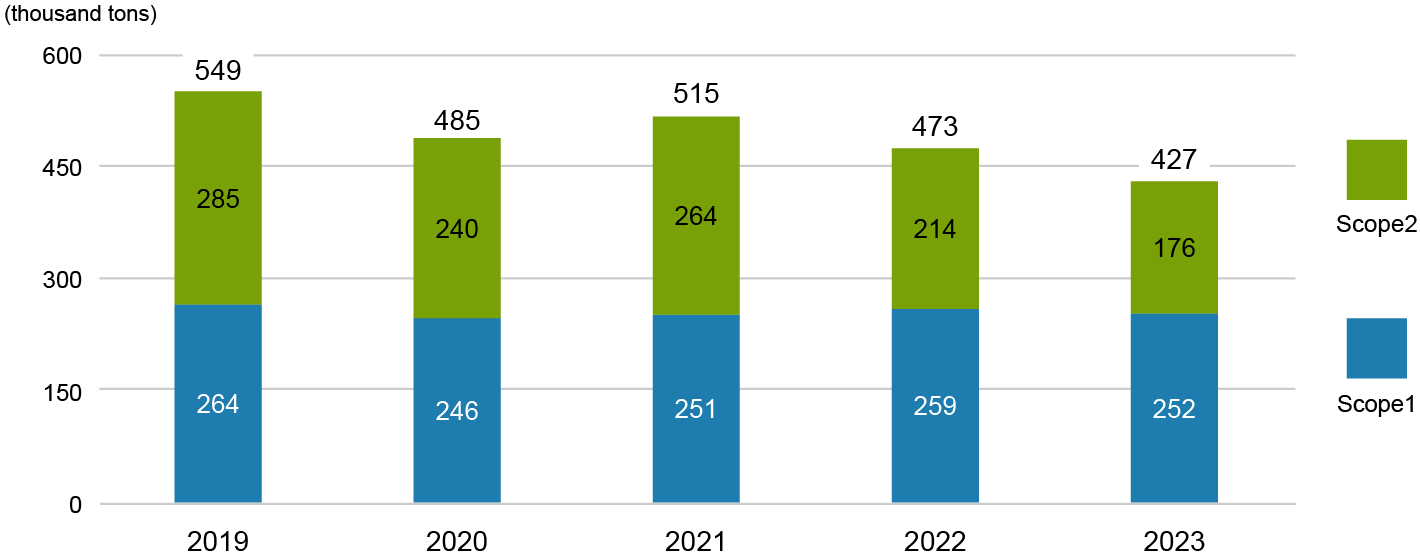 Trends in Scope 1 and 2 Emissions at Suntory Beverage & Food" loading="lazy">
Trends in Scope 1 and 2 Emissions at Suntory Beverage & Food" loading="lazy">
Energy Consumption at Suntory Beverage & Food
| 2021 | 2022 | 2023 | |
|---|---|---|---|
| Energy Consumption (MWh) | 1,841,699 | 1,979,441 | 1,953,954 |
| Renewable Energy Consumption (MWh) | 179,126 | 364,358 | 477,104 |
| Energy Intensity (MWh/KL) | 0.21 | 0.20 | 0.20 |
| Electricity Consumption (MWh) | - | - | 726,752 |
-
*Figures for renewable energy and energy consumption have been certified by a third party for results excluding non-production sites outside Japan.
Renewable energy consumption: 475,311MWh★, Electricity consumption: 720,933MWh★ -
*Third-party certification by KPMG AZSA Sustainability Co., Ltd. Third-party certified figures indicated with ★.
Scope 3 Emissions at Suntory Beverage & Food
| Category | Emissions (thousand tons CO2e) |
Calculation Method |
|---|---|---|
| 1. Purchased goods and services | 3,251★ | [Raw Materials and Packages] Calculated by multiplying the weight of raw materials and packaging materials purchased and used for products manufactured and sold by the Suntory Beverage & Food Group (in Japan and overseas) by the emission factors. 41% of Category 1 GHG emissions are calculated using emission factors calculated from the GHG emissions of suppliers of raw materials and packaging materials. For 2023, we changed the source of emission factors for packaging materials in Asia and Oceania from the prevailing Defra to IDEA Ver. 3.3. [Contract manufacturers] Calculated by multiplying the volume of the products that Suntory Beverage & Food Group (in Japan), Suntory Beverage & Food Europe, and Suntory Beverage & Food Oceania have outsourced to contract manufacturers by the emission factors. |
| 2. Capital Goods | 172★ | Calculated by multiplying the amount of capital expenditure excluding land expenditure of Suntory Beverage & Food Group by emission factors. |
| 3. Fuel and energy-related activities not included in Scope 1 or 2 | 85 | Calculated by multiplying the amount of energy consumed by Suntory Beverage & Food Group by corresponding emission factors related to the collection, production, and transportation of applicable energy resources. |
| 4. Upstream transportation and distribution | 221 | Calculated by multiplying the transportation volume in tons-km of goods owned by Suntory Beverage & Food Group by emission factors. |
| 5. Waste generated in operations | 6 | Calculated by multiplying the weight of waste disposed by Suntory Beverage & Food Group by corresponding emission factors. |
| 6. Business travel | 10 | Calculated by multiplying the amount of business travel expenses of Suntory Beverage & Food Group by corresponding emission factors. |
| 7. Employee commuting | 25 | Calculated by multiplying the amount of commuting expenses of Suntory Beverage & Food Group by corresponding emission factors. |
| 8. Upstream leased assets | 23 | Calculated by multiplying the storage volume as well as the floor area of distribution centers rented by Suntory Beverage & Food Group by emission factors. |
| 9. Downstream transportation and distribution | 233 | Calculated by multiplying the transportation volume in tons-km and sales volume of goods of Suntory Beverage & Food Group by corresponding emission factors. |
| 10. Processing of sold products | — | None |
| 11. Use of sold products | 89 | Calculated by multiplying the sales volume of goods of Suntory Beverage & Food Group by corresponding emission factors. |
| 12. End-of-life treatment of sold products | 405★ | Calculated by multiplying the weight of packaging materials purchased and used by the Suntory Beverage & Food Group by emission factors related to disposal/recycling transport and processing. |
| 13. Downstream leased assets | 313★ | Calculated by multiplying the electricity used by leased assets of Suntory Beverage & Food Group (In Japan) by emission factors. |
| 14. Franchises | 9 | Calculated as Scopes 1 and 2 CO2 emissions from the direct operations of companies and stores franchised by the Suntory Beverage & Food Group. |
| 15. Investments | — | None |
| Total | 4,843 |
-
*The Suntory Beverage & Food Group's beverage and food businesses in Japan and overseas are included in the scope. For some overseas group companies, emissions were estimated by using Japan-based emission factors or production volume in Japan.
-
*Emission factors used to calculate emissions for Japan include the following:
a) "Emission factor database for corporate GHG emissions accounting over the supply chain (Version 3.3)"
b) "LCI Database IDEA Version 3.3" (Advanced LCA Research Group, The National Institute of Advanced Industrial Science and Technology and Sustainable Management Promotion Organization) -
*Results have received independent assurance from KPMG AZSA Sustainability Co., Ltd. The assured numerical values are indicated with ★.
Plastic
Targets Toward & Progress at Suntory Beverage & Food
Targets
Toward
2030
- Switch all the PET bottles used globally to be made of recycled or plant-based material by 2030, achieving zero use of virgin petroleum-based materials.
2023
Progress
- Percentage of PET bottles made of recycled or plant-based material: 33%
- Japan
- 53%*
- Overseas
- 18%
-
*Ratio of the number of 100% sustainable bottle
By-Products and Waste Generation
As part of our efforts toward establishing a recycling-oriented society, Suntory Group is working to reduce emissions of by-products and waste and to achieve 100% recycling.
By-Products and Waste Generation Performance at Suntory Beverage & Food
| Area | Amount of discharge (thousand tons) | ||||
|---|---|---|---|---|---|
| 2019 | 2020 | 2021 | 2022 | 2023 | |
| Japan | 92 | 84 | 85 | 88 | 86 |
| Americas | 2 | 2 | 2 | 2 | 2 |
| Europe | 37 | 28 | 24 | 34 | 31 |
| Asia | 32 | 31 | 29 | 53 | 32 |
| Oceania | 5 | 7 | 7 | 6 | 3 |
| Africa | 0 | 0 | 0 | 0 | 0 |
| Total | 167 | 151 | 148 | 184 | 153 |
-
*2023: Data covers 10 production plants in Japan and 38 production plants overseas.
Recycling Rate of Japanese Plants at Suntory Beverage & Food
| 2019 | 2020 | 2021 | 2022 | 2023 | |
|---|---|---|---|---|---|
| Amount of discharge (thousand ton) | 92 | 84 | 85 | 88 | 86 |
| Amount recycled (thousand ton) | 92 | 83 | 85 | 88 | 86 |
| Recycling rate (%) | 100.0 | 99.1 | 99.3 | 100.0 | 100.0 |
-
*2023: Data covers 10 production plants in Japan.
By-Products and Waste Generation, Recycling Rate and the Purpose of Use for Recycled Products of Japanese Plants at Suntory Beverage & Food
| Type of waste | Main Purpose of Use |
2019 | 2020 | 2021 | 2022 | 2023 | |||||
|---|---|---|---|---|---|---|---|---|---|---|---|
| Generation (t) | Recycling Rate (%) | Generation (t) | Recycling Rate (%) | Generation (t) | Recycling Rate (%) | Generation (t) | Recycling Rate (%) | Generation (t) | Recycling Rate (%) | ||
| Vegetable (glycation, tea, coffee dregs, etc.) |
|
67,517 | 100 | 59,840 | 100 | 62,769 | 100 | 64,060 | 100 | 61,225 | 100 |
| Sludge (excess sludge, etc.) |
|
10,911 | 100 | 9,953 | 100 | 9,820 | 100 | 9,066 | 100 | 9,788 | 100 |
| Wood waste (cask, pallets) |
|
7 | 100 | 19 | 100 | 17 | 94 | 14 | 100 | 12 | 100 |
| Glass and ceramic scrap |
|
855 | 100 | 527 | 100 | 235 | 100 | 229 | 100 | 216 | 100 |
| Paper scraps (cardboards, paper labels, etc.) |
|
3,104 | 100 | 3,003 | 100 | 3,114 | 100 | 3,393 | 100 | 3,360 | 100 |
| Plastic |
|
3,959 | 100 | 4,035 | 100 | 3,962 | 100 | 4,169 | 100 | 4,012 | 100 |
| Metal scraps (aluminum, steel) |
|
1,389 | 100 | 1,430 | 100 | 1,351 | 100 | 1,276 | 100 | 1,266 | 100 |
| Other | 4,113 | 100 | 4,710 | 84 | 4,173 | 86 | 5,629 | 100 | 5,687 | 100 | |
| Total | 91,856 | 100 | 83,517 | 99.1 | 85,440 | 99.3 | 87,835 | 100 | 85,566 | 100 | |
-
*2023:Data covers 10 production plants in Japan.
Social Data
Employment Status of Suntory Beverage & Food
Status at Suntory Beverage & Food (Japan) as of December 31, 2022 is as below.
Number of Employees(as of December 31, 2022)
(employees)
| 2018 | 2019 | 2020 | 2021 | 2022 | |||
|---|---|---|---|---|---|---|---|
| Men | 14 | 14 | 14 | 14 | 18 | ||
| Women | 3 | 3 | 3 | 3 | 3 | ||
| Executives | 17 | 17 | 17 | 17 | 21 | ||
| Men | 654 | 668 | 686 | 676 | 682 | ||
| Women | 40 | 42 | 47 | 66 | 68 | ||
| Managers | 694 | 710 | 733 | 742 | 750 | ||
| Men | 729 | 708 | 669 | 897 | 843 | ||
| Women | 239 | 252 | 262 | 323 | 330 | ||
| Members | 968 | 960 | 931 | 1220 | 1173 | ||
| Employees | 1662 | 1670 | 1664 | 1962 | 1923 | ||
| Men | 28 | 30 | 38 | 45 | 27 | ||
| Women | 113 | 115 | 128 | 131 | 134 | ||
| Contract employees, etc* | 141 | 145 | 166 | 176 | 161 | ||
| Temporary staff | 66 | 58 | 57 | 52 | 61 | ||
-
*Contract and temporary employees: Special contract employees, part-time employees, added SBF partner employees from 2018.
-
*SBF Partner Employees: Temporary staff that have become permanent employees.
Number of Employees(as of December 31, 2022)
(employees)
| 2018 | 2019 | 2020 | 2021 | 2022 | |
|---|---|---|---|---|---|
| Men | 1383 | 1376 | 1355 | 1573 | 1525 |
| Women | 279 | 294 | 309 | 389 | 398 |
| Total | 1662 | 1670 | 1664 | 1962 | 1923 |
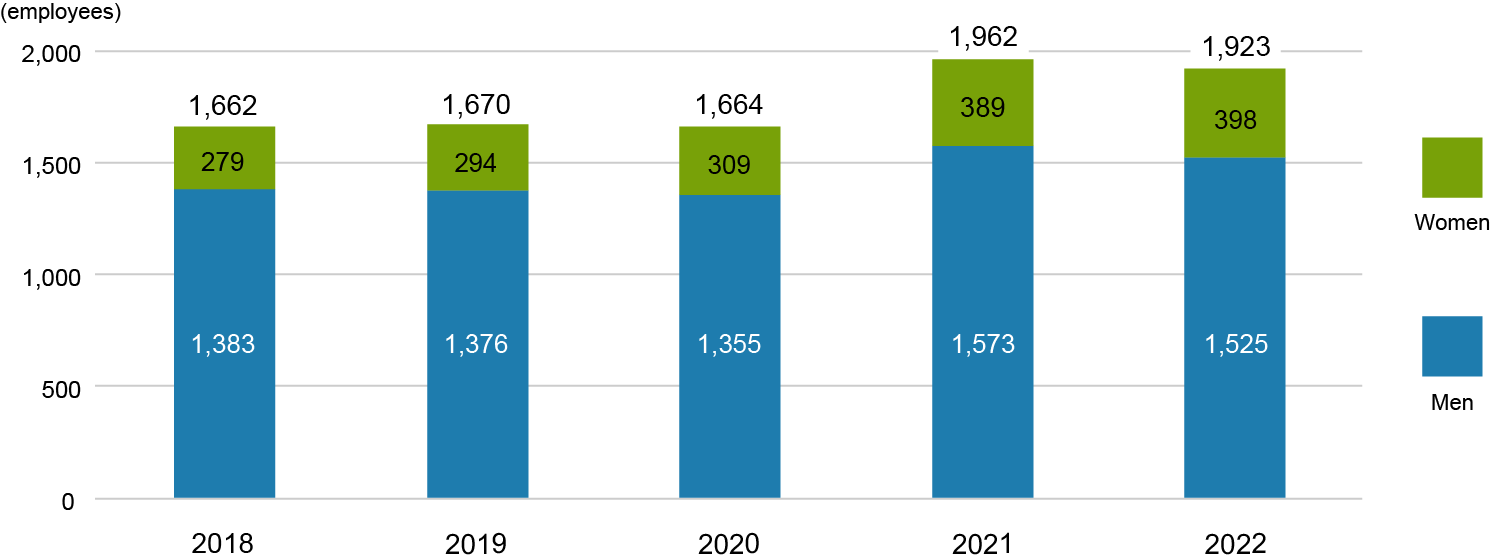
Average Age and Average Length of Employment(as of December 31, 2022)
| 2018 | 2019 | 2020 | 2021 | 2022 | |
|---|---|---|---|---|---|
| Average age | 42.6 | 42.8 | 42.9 | 42.0 | 42.2 |
| Average tenure | 18.1 | 18.3 | 18.4 | 17.4 | 17.6 |
Number of Newly Hired Employees
(employees)
| 2018 | 2019 | 2020 | 2021 | 2022 | |||
|---|---|---|---|---|---|---|---|
| New graduates | Men | 16 | 24 | 20 | 19 | 13 | |
| Women | 16 | 18 | 18 | 13 | 12 | ||
| Experienced workers | Men | 5 | 1 | 3 | 2 | 0 | |
| Women | 5 | 0 | 1 | 0 | 9 | ||
| Total | 42 | 43 | 42 | 34 | 34 | ||
| Experienced workers ratio | 10% | 6% | 26% | ||||
Number of Resignees and Reasons/Turnover Rate
(employees)
| 2018 | 2019 | 2020 | 2021 | 2022 | ||
|---|---|---|---|---|---|---|
| Retirement*1 | 18 | 25 | 35 | 43 | 33 | |
| Personal circumstances*2 | 7 | 11 | 19 | 19 | 7 | |
| Corporate circumstances*3 | 0 | 0 | 0 | 0 | 0 | |
| Others | 0 | 0 | 0 | 3 | 2 | |
| Total*3 | 25 | 36 | 54 | 65 | 42 | |
| Turnover rate*4 | 0.42% | 0.66% | 1.14% | 0.97% | 0.30% | |
-
*1Retirement includes flexible-age retirement
-
*2Company circumstances include factory closings and selling of business. Individual circumstances include employment transfers.
-
*3Covers full-time employees
-
*4The turnover rate is calculated excluding mandatory age retirement
Retention Rate of New Graduate Hires
| Length of employment years | 1 | 2 | 3 | 4 | 5 |
|---|---|---|---|---|---|
| Percentage of employees | 100.0% | 96.6% | 91.8% | 87.80% | 87.50% |
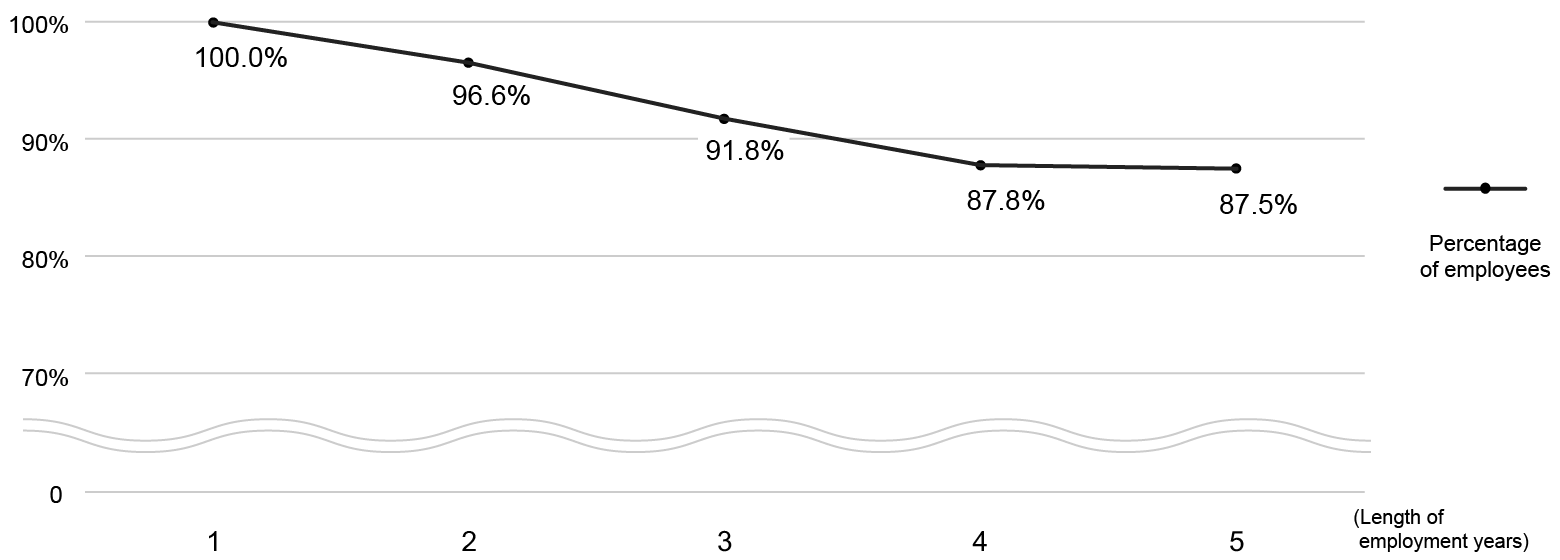
-
*Calculated for new graduates hired by Suntory Group that entered the company from 2015 to 2017.
Women Employed in Japan
(as of December 31, 2022)
(employees)
| 2018 | 2019 | 2020 | 2021 | 2022 | ||
|---|---|---|---|---|---|---|
| Number | Executives | - | - | - | 3 | 3 |
| General Manager | 28 | 32 | 35 | 35 | 36 | |
| Team Leader | - | - | - | - | - | |
| Ratio | Executives | - | - | - | 17.6% | 14.30% |
| General Manager | 5.2% | 5.7% | 6.3% | 6.8% | 7.0% | |
| Team Leader | - | - | - | - | - | |
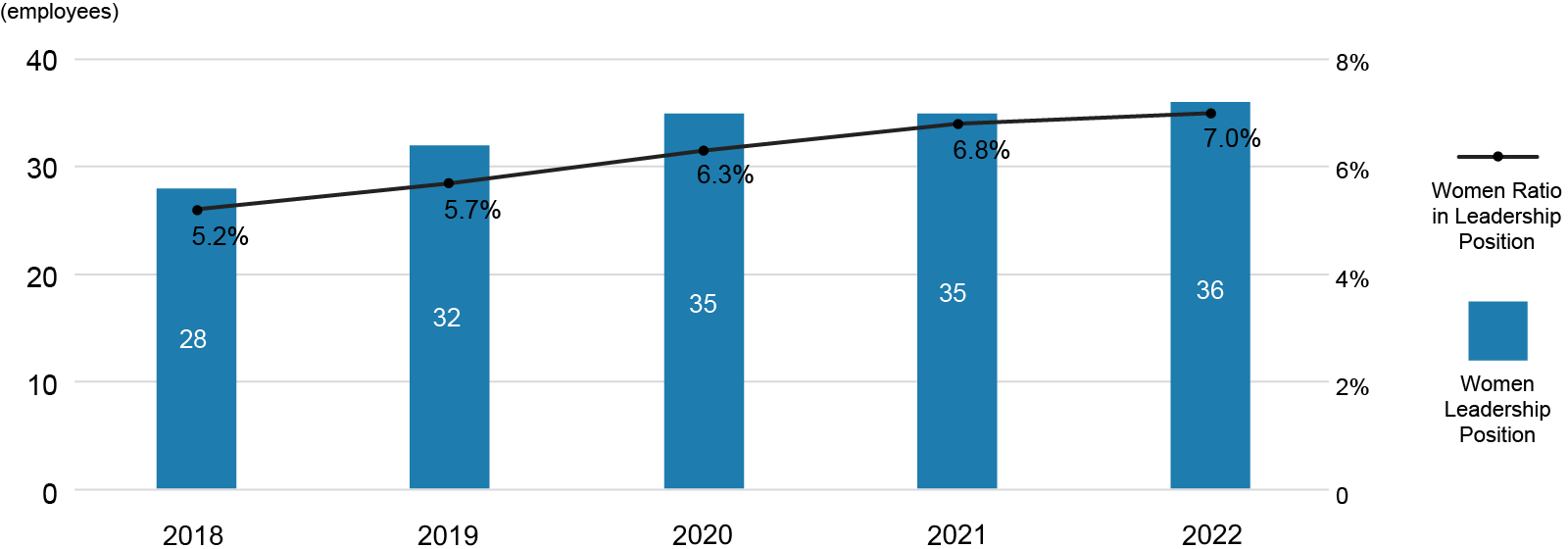
Number of Men and Women Employees by Management or Non-management Position
(as of December 31, 2022)
(employees)
| 2021 | 2022 | ||
|---|---|---|---|
| Manager | Men | 479 | 476 |
| Women | 35 | 36 | |
| Non-manager | Men | 1094 | 1049 |
| Women | 354 | 362 | |
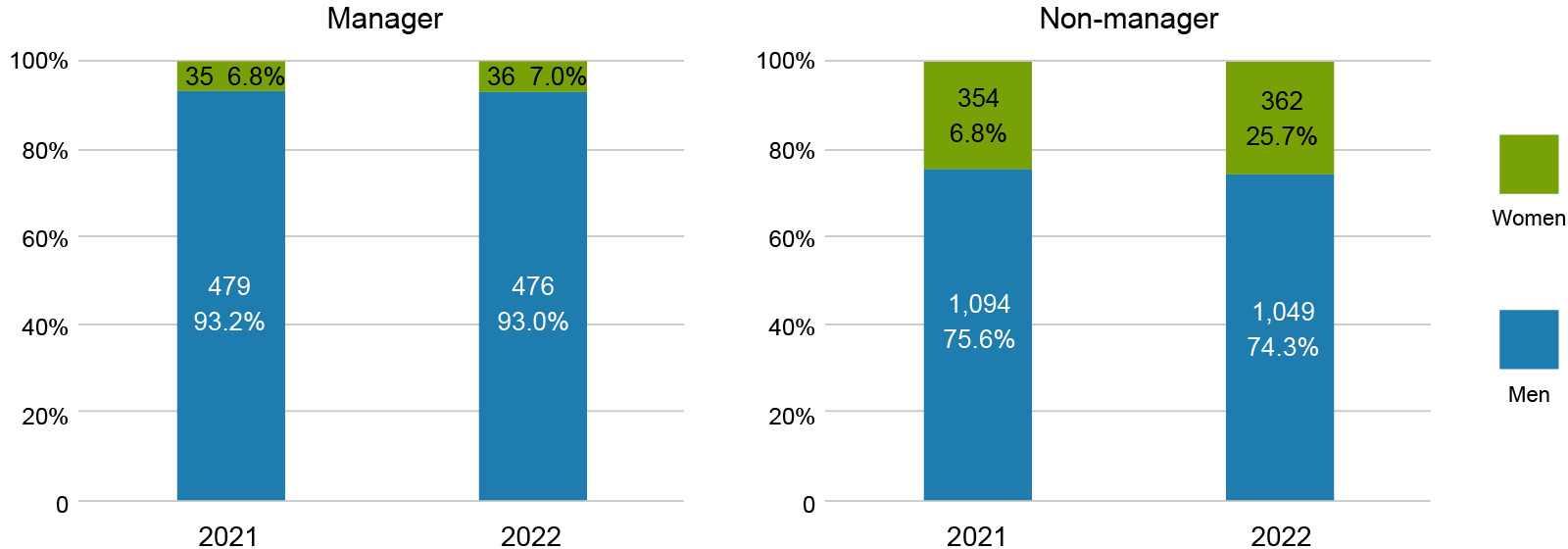
Number of Employees with Disabilities and Employment Rate(as of June 1, 2022)
(employees)
| 2018 | 2019 | 2020 | 2021 | 2022 | |
|---|---|---|---|---|---|
| Employees with disabilities | 32 | 38 | 35 | 41 | 41 |
| Employees with disabilities employment rate | 2.27% | 2.79% | 2.66% | 2.69% | 2.65% |
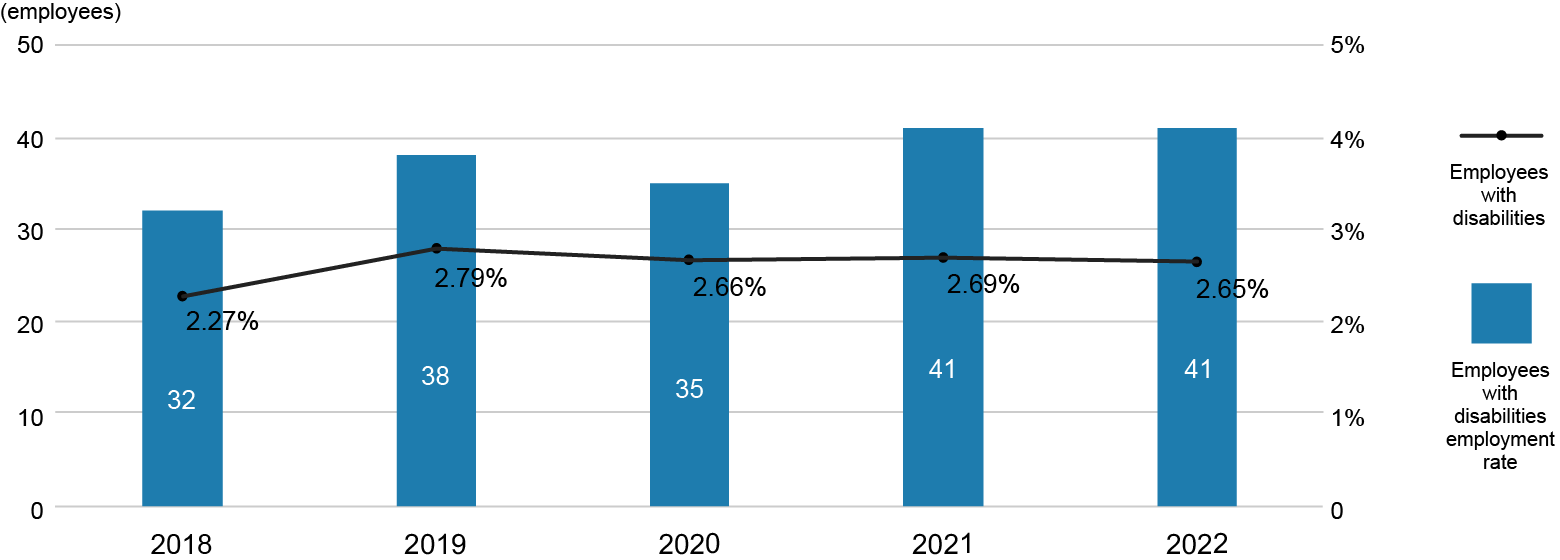
Total Actual Annual Working Hours
(hour)
| 2018 | 2019 | 2020 | 2021 | 2022 | |
|---|---|---|---|---|---|
| Overtime work hours | 244 | 246 | 222 | 223 | 226 |
| Official working hours − vacation hours taken |
1694 | 1685 | 1693 | 1686 | 1682 |
| Total | 1938 | 1931 | 1915 | 1909 | 1908 |
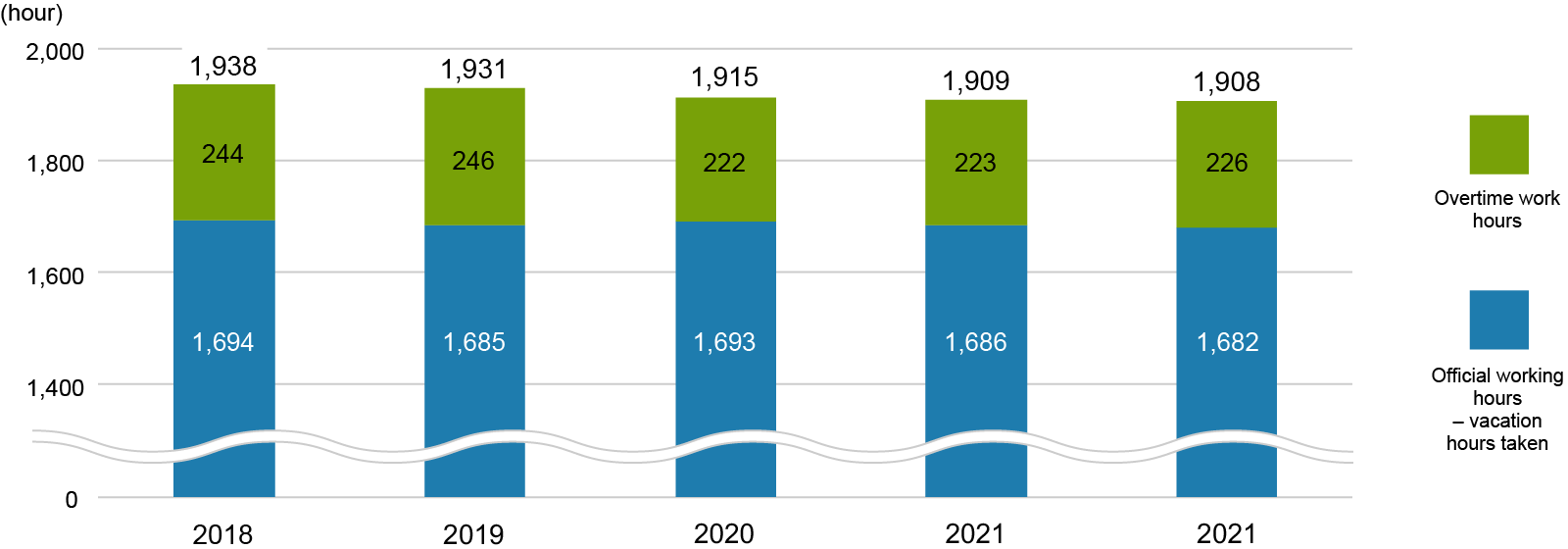
Annual Paid Vacations Taken
(hour)
| 2018 | 2019 | 2020 | 2021 | 2022 | |
|---|---|---|---|---|---|
| Annual paid vacations taken in hours | 126 | 131.3 | 128.3 | 128 | 131 |
| Percentage of annual paid vacations taken | 78.1% | 81.4% | 79.5% | 73.1% | 78.60% |
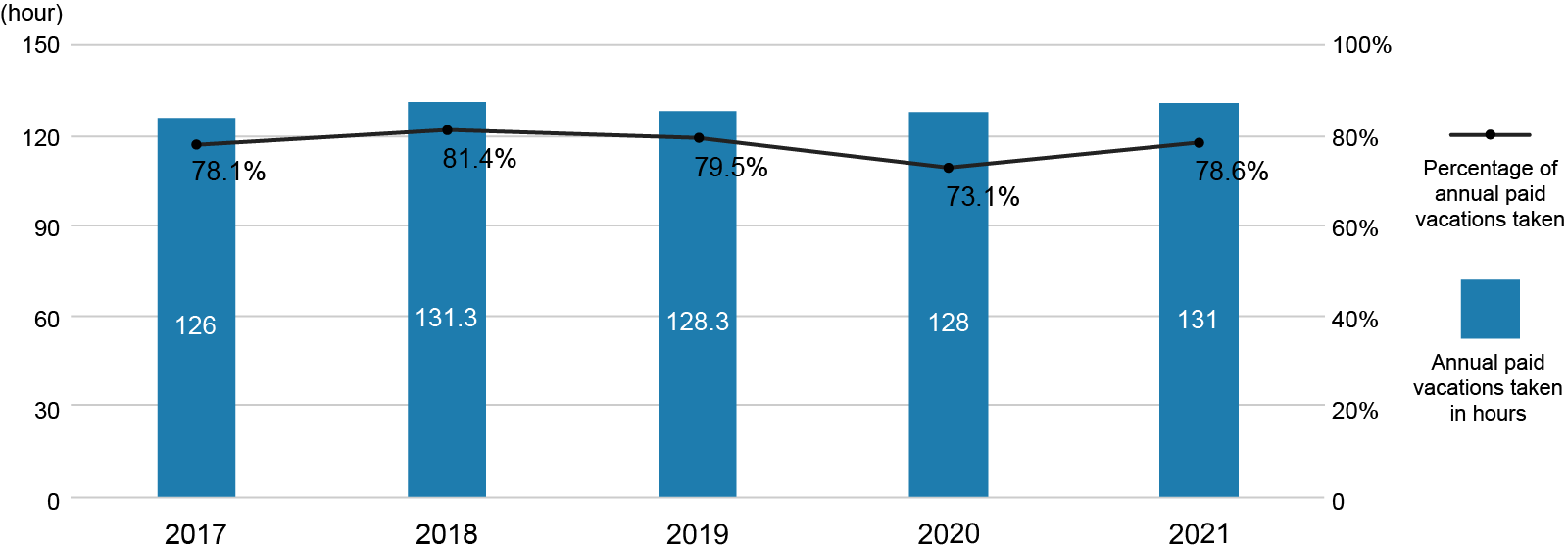
Results of Employees Taking Child Care Leave
(employees)
| 2018 | 2019 | 2020 | 2021 | 2022 | |
|---|---|---|---|---|---|
| Persons taking childcare leave | 53 | 34 | 70 | 104 | 115 |
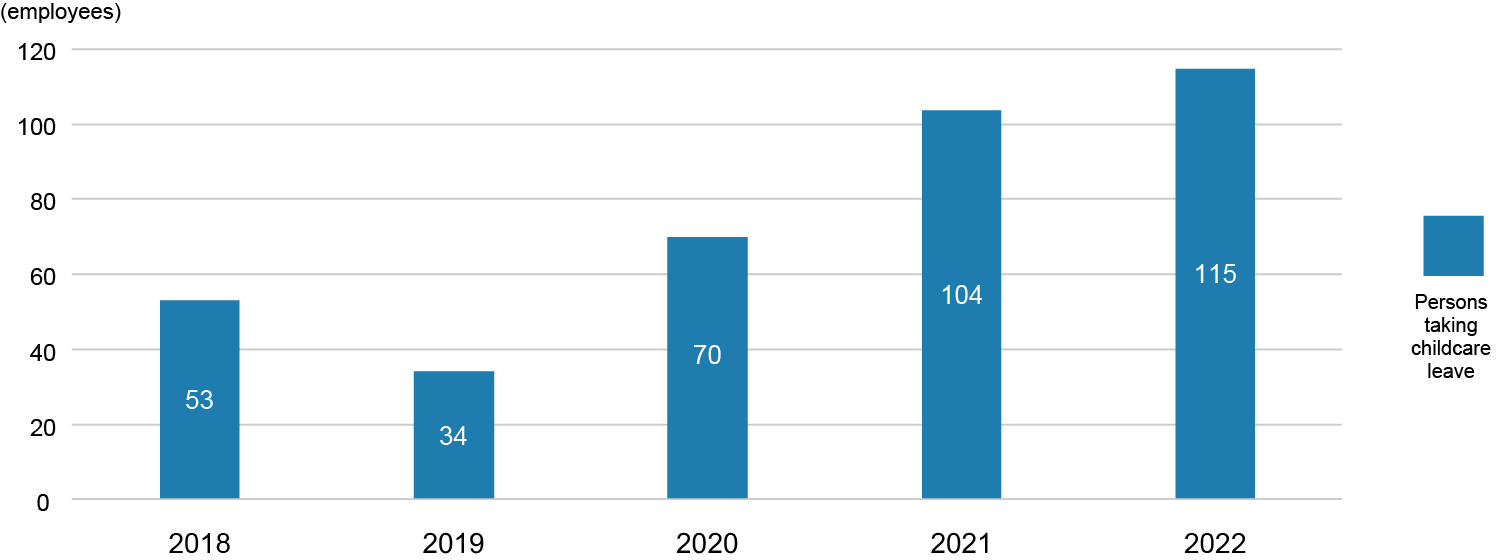
Change in the Number of Employees that Took Advantage of Child or Nursing Care Policies
(employees)
| 2018 | 2019 | 2020 | 2021 | 2022 | |||
|---|---|---|---|---|---|---|---|
| Child and nursing care | Childcare leave | 53 | 34 | 70 | 104 | 115 | |
| Shortened and staggered working hour for childcare | Men | 27 | 10 | 37 | 47 | 42 | |
| Women | 27 | 24 | 40 | 68 | 73 | ||
| Newly taking childcare leave | 12 | 8 | 20 | 39 | 41 | ||
| Number of employees returning after childcare leave | Men | 24 | 22 | 32 | 32 | 48 | |
| Women | 13 | 17 | 11 | 24 | 34 | ||
| Number of employees that resigned during childcare leave | Men | 0 | 0 | 0 | 0 | 0 | |
| Women | 0 | 0 | 0 | 1 | 0 | ||
| Ratio of employees returning after childcare leave | Men | 100.0% | 100.0% | 100.0% | 100.0% | 100.0% | |
| Women | 100.0% | 100.0% | 100.0% | 96.0% | 100.0% | ||
| Number of employees remaining at end of the year after taking childcare leave previous year | Men | 34 | 27 | 23 | 44 | 35 | |
| Women | 25 | 26 | 27 | 46 | 63 | ||
| Ratio of employees returning from childcare leave | Men | 100.0% | 100.0% | 100.0% | 100.0% | 97.20% | |
| Women | 83.3% | 96.3% | 100.0% | 100.0% | 97.00% | ||
| Shortened and staggered working hour for childcare | 37 | 54 | 33 | 28 | 37 | ||
| Nursing leave | 0 | 0 | 0 | 1 | 0 | ||
| Shortened and staggered working hour for nursing care | 0 | 0 | 0 | 0 | 2 | ||
| Telecommuting program | 5,176 | 5,674 | 6,696 | 6,921 | 6,952 | ||
| Child support leave | 75 | 102 | 160 | 153 | 159 | ||
| Home helper | 0 | 0 | 0 | 1 | 0 | ||
| At home childcare service | 5 | 8 | 5 | 12 | 20 | ||
| Vacation | Refresh leave | 194 | 253 | 164 | 219 | 293 | |
Other Development Programs in Japan
(employees)
| Name | Description | Number of participants 2021 | 2011-2021 |
|---|---|---|---|
| Career Challenge Program | Individual tailored program for junior employees to enhance skills needed for global business (language, cultural awareness, cross-cultural communication, leadership, logical thinking, management through figures, etc.) | 2 | 26 |
| Company sponsored MBA | Sending talented high potential employees to overseas top business schools to study in global environment. | 0 | 3 |
| Trainee program | Trainees brush up their professional skills, gain language and communication skills, global business skills, and leadership skills through the one year on-site training at overseas companies. | 5 | 32 |
Main Self-development Programs and the Number of Participants in FY2022
(employees)
| Type of training | Description | People |
|---|---|---|
| Elective training | Elective training provides approximately 40 different types of courses (twice/year) with training designed to teach the necessary business skills to succeed in the career plans envisioned by our employees | 746 |
| Enhancing English ability* | This program provides various courses such as in-office English lessons and online lessons aimed to enhance business communications skills in English. A wide range of support content is available so that students can effectively take the course best suited for their skill level. | 207 |
| e-Learning | We offer programs from 5 external partners that you can take freely online. The programs cover a wide range of contents from business skill acquisition to private life-related matters. We support self learning anywhere during hiatus. This training program aims to heighten the ability to execute operations and gain the knowledge required for operational innovation. The courses include business skills, language acquisition, and computer skills. |
283 |
| Financial Support System for Attending School and Distance Learning | Suntory provides support for up to half the costs of schools and distance learning programs aimed at improving students skills (up to maximum limit). The courses that can be taken range from the skills necessary to execute operations (accounting, legal knowledge, etc.) to improving language skills and acquiring certifications |
17 |
-
*These are elective programs that employees can participate on their own accord which the company will take on some of the training costs
Income Taxes Paid
Income Taxes Paid of Suntory Beverage & Food
| Japan | Overseas | Total | |
|---|---|---|---|
| 2022 | 5.3 | 23.3 | 28.6 |
| 2023 | 11.6 | 24.9 | 36.5 |
-
*The above amounts are based on "Country-by-Country Report" submitted to Japanese Tax Authorities, and not directly related to the Consolidated Financial Statements.